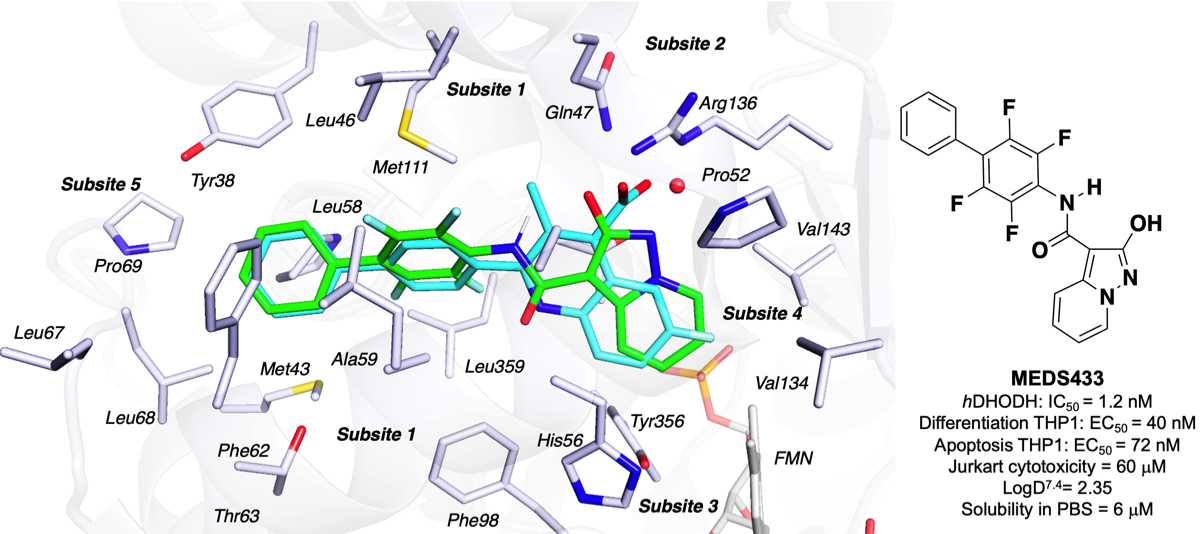Targeting human Dihydrooroate Dehydrogenase (hDHODH)
hDHODH plays a central role in the de novo pyrimidine synthesis and has been validated as a therapeutic target for the treatment of autoimmune diseases (rheumatoid arthritis and multiple sclerosis), and, in particular, acute myeloid leukemia (AML), whose care hasn't changed in four decades.
Since 2012, MEDSynth has focused on creating innovative hDHODH inhibitors using a scaffold-hopping approach on Brequinar structure, one of the most potent hDHODH inhibitors in clinical study. Our top candidate, MEDS433, restores myeloid differentiation in leukemia cell lines eight times more effectively than brequinar. MEDS433 is in late-stage in vivo evaluations, nearing clinical trials for AML (see our spin-off page).
During the COVID-19 pandemic, hDHODH was tested as a treatment option against SARS-CoV-2. In March 2020, hDHODH inhibitors showed effectiveness in inhibiting virus replication and reducing inflammation from cytokine storms. MEDS433 also demonstrated strong anti-SARS-CoV-2 activity with an optimal safety index (SI).

Collaborations
- Prof. Tiziano Tuccinardi, Molecular Modelling and Virtual Screening Laboratory, Dep. of Pharmacy, University of Pisa (IT)
- Prof. Riccardo Miggiano, Structural biology, Dep. of Drug Sciences, University of Piemonte Orientale, Novara (IT)
- Dr. Renzo Bagnati, Mass Spectrometry Laboratory, Dep. of Environmental Health Sciences, Istituto di Ricerche Farmacologiche Mario Negri, Milano (IT)
- Dr. Paola Circosta, Molecular Biotechnology Center, University of Torino (IT)
- Prof. Marco Piccinini, Department of Oncology, University of Torino (It)
- Dr. Valentina Gaidano, Department of Clinical and Biological Sciences, University of Torino (IT)
- Prof. Salam Al-Karadaghi, Department of Biochemistry and Structural Biology, University of Lund (SW)
- Prof. Giuseppe Saglio, Division of Hematology and Cell Therapy, AO Ordine Mauriziano, Torino (IT)
- ATOMWISE, INC., 250 Sutter St., Suite 650, San Francisco, California (USA)
Representative pubblications
- A. Luganini, G. Sibille, M. Pavan, M. Mello Grand; S. Sainas, D. Boschi , M. L. Lolli , G. Chiorino, G. Gribaudo. Mechanisms of antiviral activity of the new hDHODH inhibitor MEDS433 against respiratory syncytial virus replication. Antivir, Res. 2023, 219, 105734. https://doi.org/10.1016/j.antiviral.2023.105734
- S. Sainas, M. Giorgis, P. Circosta, G. Poli, M. Alberti, A. Passoni, V. Gaidano, A.C. Pippione, N. Vitale, D. Bonanni, B. Rolando, A. Cignetti, C. Ramondetti, A. Lanno, D.M. Ferraris, B. Canepa, B. Buccinnà, M. Piccinini, M. Rizzi, G. Saglio, S. Al-Karadaghi, D. Boschi, R. Miggiano, T. Tuccinardi, M.L. Lolli. Targeting Acute Myelogenous Leukemia Using Potent Human Dihydroorotate Dehydrogenase Inhibitors Based on the 2-Hydroxypyrazolo[1,5-a ]pyridine Scaffold: SAR of the Aryloxyaryl Moiety J. Med. Chem. 2022, 65 (19), 12701-12724. https://pubs.acs.org/doi/10.1021/acs.jmedchem.2c00496
- Sainas, S.; Giorgis, M.; Circosta, P.; Gaidano, V.; Bonanni, D.; Pippione, A. C.; Bagnati, R.; Passoni, A.; Qiu, Y.; Cojocaru, C. F.; Canepa, B.; Bona, A.; Rolando, B.; Mishina, M.; Ramondetti, C.; Buccinnà, B.; Piccinini, M.; Houshmand, M.; Cignetti, A.; Giraudo, E.; Al-Karadaghi, S.; Boschi, D.; Saglio, G.; Lolli, M. L. Targeting Acute Myelogenous Leukemia Using Potent Human Dihydroorotate Dehydrogenase Inhibitors Based on the 2-Hydroxypyrazolo[1,5-a]Pyridine Scaffold: SAR of the Biphenyl Moiety. J. Med. Chem. 2021, 64 (9), 5404–5428.https://doi.org/10.1021/acs.jmedchem.0c01549
- Gaidano,V.; Houshmand, M.; Vitale, N.; Carrà, G.; Morotti, A.; Tenace, V.; Rapelli, S.; Sainas, S.; Pippione, A.C.; Giorgis, M.; et al. The Synergism between DHODH Inhibitors and Dipyridamole Leads to Metabolic Lethality in Acute Myeloid Leukemia. Cancers. 2021, 13, 1003. https://doi.org/10.3390/cancers13051003
- Sainas, S.; Pippione, A. C.; Lupino, E.; Giorgis, M.; Circosta, P.; Gaidano, V.; Goyal, P.; Bonanni, D.; Rolando, B.; Cignetti, A.; Ducime, A.; Andersson, M.; Järvå, M.; Friemann, R.; Piccinini, M.; Ramondetti, C.; Buccinnà, B.; Al-Karadaghi, S.; Boschi, D.; Saglio, G.; Lolli, M. L.Targeting myeloid differentiation using potent 2-hydroxypyrazolo[1,5-a]pyridine scaffold-based human dihydroorotate dehydrogenase (hDHODH) inhibitors. J. Medicinal Chemistry, 2018, 61 (14), 6034-6055. https://doi.org/10.1021/acs.jmedchem.8b00373
Sainas S., Pippione A. C., Giorgis M., Lupino E., Goyal P., Ramondetti C., Buccinnà B., Piccinini M., Braga R. C., Andrade C. H., Andersson M., Moritzer A.C., Friemann R., Mensa S., Al-Karadaghi S., Boschi D., Lolli M. L. Design, synthesis, biological evaluation and X-ray structural studies of potent human dihydroorotate dehydrogenase inhibitors based on hydroxylated azole scaffolds. Eur. J. Med. Chem. 2017, 129, 287-302, doi: 10.1016/j.ejmech.2017.02.017
S. Bonomo, P. Tosco, M. Giorgis, M. Lolli, R. Fruttero The role of fluorine in stabilizing the bioactive conformation of dihydroorotate dehydrogenase inhibitors. Journal of Molecular Modeling 2013, 19(3), 1099-1107 doi: 10.1007/s00894-012-1643-5
M. L. Lolli, M. Giorgis, P. Tosco, A. Foti, R. Fruttero and A. Gasco New inhibitors of dihydroorotate dehydrogenase (DHODH) based on the 4-hydroxy-1,2,5-oxadiazol-3-yl (hydroxyfurazanyl) scaffold. Eur J Med Chem 2012, 49, 102-9 doi: 10.1016/j.ejmech.2011.12.038